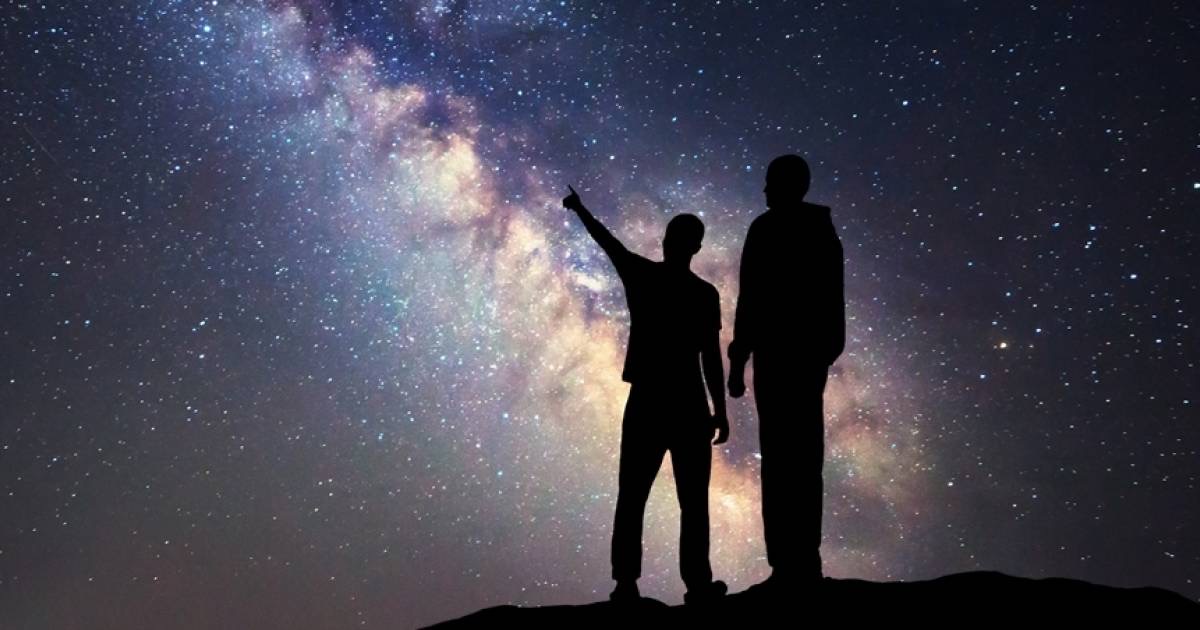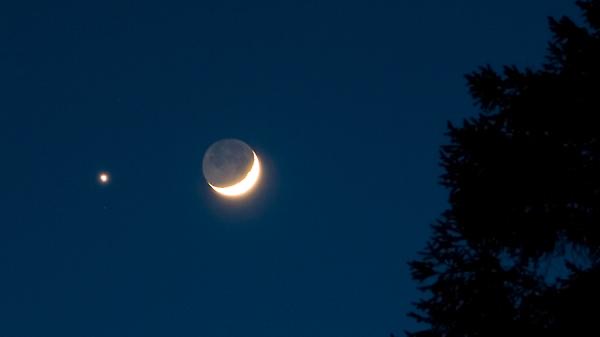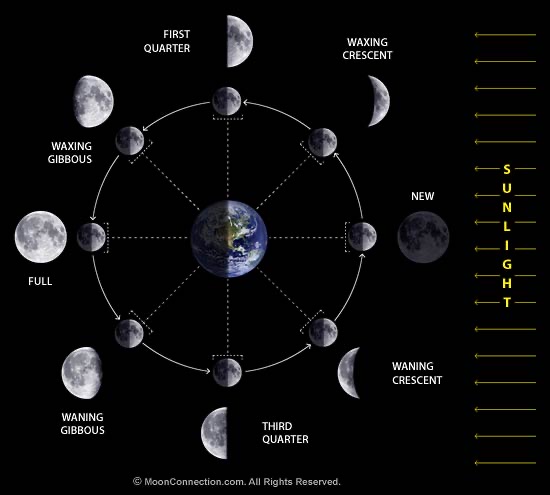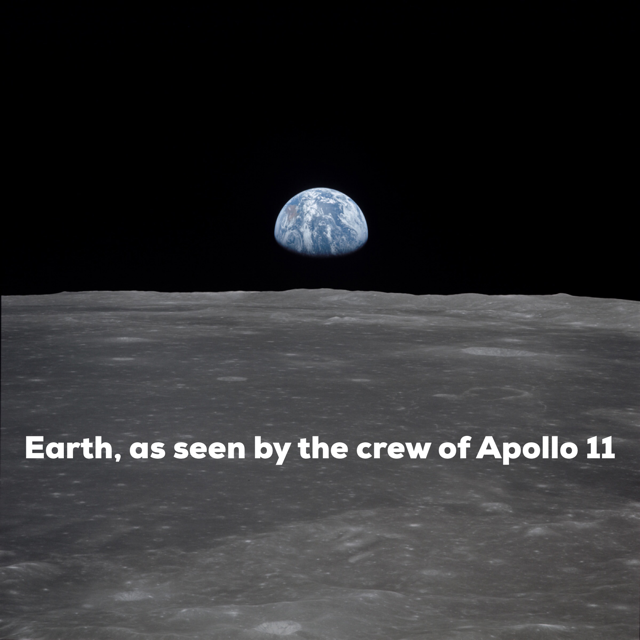 Astronomy is not something that is only accessible to those who own expensive telescopes, it is a pursuit that we can all engage in by using nothing more than our unaided eyes. Things like learning how to identify the brightest stars in the night sky and the constellations to which they belong are a good example, but there are others. Identifying the 5 naked eye planets, observing meteor showers, and even observing man-made objects such the International Space Station are all activities that require nothing more than a clear sky and your own desire to get outside and look up. The moon is a fascinating object too and, at an average distance of only 240,000 miles, it is practically in your backyard. There are plenty of things to observe with the moon naked eye: the larger dark seas of dried lava, otherwise known as “maria” (the singular being “mare”), watching a full moon on the rise to experience the famous “moon illusion” (a full moon seen near the horizon always appear bigger than when it is overhead), or observing its cycle of phases from new moon to full and then back again to new moon. This latter exercise can be more than just an “identify the phase” game, it can also provide you with insight into the moon’s motion as it and the Earth do their monthly dance around each other. It can also provide you with an insight into the Earth-moon system that you might not have considered before. This month, we are going to use a phenomenon known as “Earthshine” to help illuminate (*ahem*) an interesting perspective on the Earth, the moon, and its phases.
Astronomy is not something that is only accessible to those who own expensive telescopes, it is a pursuit that we can all engage in by using nothing more than our unaided eyes. Things like learning how to identify the brightest stars in the night sky and the constellations to which they belong are a good example, but there are others. Identifying the 5 naked eye planets, observing meteor showers, and even observing man-made objects such the International Space Station are all activities that require nothing more than a clear sky and your own desire to get outside and look up. The moon is a fascinating object too and, at an average distance of only 240,000 miles, it is practically in your backyard. There are plenty of things to observe with the moon naked eye: the larger dark seas of dried lava, otherwise known as “maria” (the singular being “mare”), watching a full moon on the rise to experience the famous “moon illusion” (a full moon seen near the horizon always appear bigger than when it is overhead), or observing its cycle of phases from new moon to full and then back again to new moon. This latter exercise can be more than just an “identify the phase” game, it can also provide you with insight into the moon’s motion as it and the Earth do their monthly dance around each other. It can also provide you with an insight into the Earth-moon system that you might not have considered before. This month, we are going to use a phenomenon known as “Earthshine” to help illuminate (*ahem*) an interesting perspective on the Earth, the moon, and its phases.
WHAT IS EARTHSHINE AND WHEN CAN YOU SEE IT?
 Have you ever looked at a crescent moon and noticed that you can also see the rest of the moon, albeit very dimly illuminated? That very faintly illuminated portion of the moon is the result of Earthshine. So, where does this light come from? You probably already know that the moon does not produce any light of its own, all of its light comes from sunlight striking the lunar surface and then being reflected back to our eyes here on Earth. And you might not think it, but the moon’s surface is actually not a very good reflector of light. In fact, the moon’s surface has about as much reflectivity as does asphalt. The Earth on the other hand is a very good reflector. Our planet’s clouds and oceans are much more reflective than the lunar surface, plus, the Earth is about four times as big as the moon, making it a very big mirror indeed. So, Earthshine is incidental sunlight being bounced off of the Earth’s surface and onto the moon and then back again to our eyes here on the Earth. The bright crescent portion is sunlight being bounced directly back to the Earth. Incidentally, another name for Earthshine is “the young moon in the old moon’s arms”, a much more poetic turn of phrase in my humble opinion. Other names for the phenomena are the “ashen glow” and the “Da Vinci glow”, in honor of Leonardo Da Vinci, the first person to accurately explain the effect.
Have you ever looked at a crescent moon and noticed that you can also see the rest of the moon, albeit very dimly illuminated? That very faintly illuminated portion of the moon is the result of Earthshine. So, where does this light come from? You probably already know that the moon does not produce any light of its own, all of its light comes from sunlight striking the lunar surface and then being reflected back to our eyes here on Earth. And you might not think it, but the moon’s surface is actually not a very good reflector of light. In fact, the moon’s surface has about as much reflectivity as does asphalt. The Earth on the other hand is a very good reflector. Our planet’s clouds and oceans are much more reflective than the lunar surface, plus, the Earth is about four times as big as the moon, making it a very big mirror indeed. So, Earthshine is incidental sunlight being bounced off of the Earth’s surface and onto the moon and then back again to our eyes here on the Earth. The bright crescent portion is sunlight being bounced directly back to the Earth. Incidentally, another name for Earthshine is “the young moon in the old moon’s arms”, a much more poetic turn of phrase in my humble opinion. Other names for the phenomena are the “ashen glow” and the “Da Vinci glow”, in honor of Leonardo Da Vinci, the first person to accurately explain the effect.
The best times to see Earthshine are going to be whenever the moon is in a crescent phase, this means about one to five days before and after new moon. This month, new moon falls on April 22nd (Earth Day as a matter of fact). So, from about April 16 to April 21, look for the crescent moon above the eastern horizon before sunrise and during the early evening hours, right after sunset, in the western sky from April 23 to April 28. According to NASA, the reflectivity of our planet changes seasonally and during the months of April and May, Earthshine is at its most intense, being 10% brighter than on average.
A QUICK DETOUR
 The opposite of Earthshine would be “moonshine”. This got me to thinking, how did the term “moonshine” become applicable to the illegally manufactured alcoholic beverages otherwise known as “hooch”, “homebrew”, “mountain dew”, “white lightning” or “mash”? It seems that the word “moonshine” originated in Great Britain during the 18th century. It was initially used as a verb that referred to activities (usually illicit) done at night under the light of a bright moon. From the 1920’s to the early 1930’s, the term was applied to the makers (“moonshiners”) of illegal alcohol (“moonshine”) during Prohibition and was an active enterprise here in Arkansas during that time. Moonshiners often worked under the light of a bright moon in order to evade detection by the authorities.
The opposite of Earthshine would be “moonshine”. This got me to thinking, how did the term “moonshine” become applicable to the illegally manufactured alcoholic beverages otherwise known as “hooch”, “homebrew”, “mountain dew”, “white lightning” or “mash”? It seems that the word “moonshine” originated in Great Britain during the 18th century. It was initially used as a verb that referred to activities (usually illicit) done at night under the light of a bright moon. From the 1920’s to the early 1930’s, the term was applied to the makers (“moonshiners”) of illegal alcohol (“moonshine”) during Prohibition and was an active enterprise here in Arkansas during that time. Moonshiners often worked under the light of a bright moon in order to evade detection by the authorities.
NOW BACK TO OUR REGULARLY SCHEDULED PROGRAM
 Okay, so the moon’s phases are a result of the ever-varying moon-Earth-Sun angle as our natural satellite moves about in its orbit. As its position, relative to the other two bodies, changes, we see different portions of its surface being illuminated from our vantage point here on the Earth. So, if the moon goes through phases, does the Earth do so as well? Yes! The late, great Carl Sagan once said, “Imagination will often take us to worlds that never were. But without it, we go nowhere”. That’s one of the things I love about astronomy, it forces you to use your imagination and a different perspective from time to time in order to gain a better understanding of the universe (and, once you get into the habit of changing perspectives, it can help you in trying to understand more worldly things too). So, I’m going to ask you to use your imagination and switch your perspective from that of an Earthbound observer to that of a lunar bound observer.
Okay, so the moon’s phases are a result of the ever-varying moon-Earth-Sun angle as our natural satellite moves about in its orbit. As its position, relative to the other two bodies, changes, we see different portions of its surface being illuminated from our vantage point here on the Earth. So, if the moon goes through phases, does the Earth do so as well? Yes! The late, great Carl Sagan once said, “Imagination will often take us to worlds that never were. But without it, we go nowhere”. That’s one of the things I love about astronomy, it forces you to use your imagination and a different perspective from time to time in order to gain a better understanding of the universe (and, once you get into the habit of changing perspectives, it can help you in trying to understand more worldly things too). So, I’m going to ask you to use your imagination and switch your perspective from that of an Earthbound observer to that of a lunar bound observer.

From the moon, the Earth is going to loom large in your sky. Remember, the Earth’s apparent diameter as seen from the lunar surface is going to be 4 times greater than that of a full moon viewed from the surface of our own planet. From the moon, you would see the Earth go through a set of phases too. However, the phases are the exact opposite for what a terrestrial observer would be seeing for the moon. For example, during new moon, we do not see the moon from here on Earth, as it lies in between us and the Sun. But, on the moon, the Earth now lies opposite the Sun so we would see a full Earth. A few days later, the terrestrial observer sees a crescent moon, but from the lunar surface, an observer would see a “gibbous” (nearly full” Earth). And this is why Earthshine is so pronounced during a crescent phase of the moon: from the moon’s perspective, the Earth is nearly full, and this allows much more of its incidental light to provide a twilight glow on the moon’s night side. And by the way, there is no such things as the “dark side of the moon”. All portions of the moon see an equal amount of day and night.
Now, if you own a pair of binoculars or small backyard telescope, use them to explore the areas illuminated by Earthshine. What do you see? Can you make out features on the lunar surface? Try sketching what you see. The art doesn’t have to be a masterpiece, it’s being done to help make you a better observer. Alternatively, you can hold up your cell phone camera to the eyepiece of a telescope and record what you see. Drop me a line and let me know what your experiences are like with Earthshine.
See, there really is a lot of astronomy you can do with nothing more than your unaided eye, a little imagination and curiosity, and, of course, the desire to simply step outside and look up in both awe and wonder.